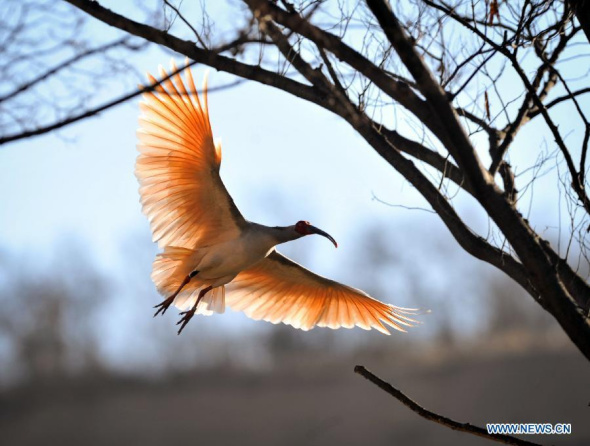
A crested ibis flies in the forest at Tongchuan City, northwest China's Shaanxi province, Dec 16, 2014. The number of crested ibis in Shaanxi province has increased from 7 in 1981 to more than 2,000 by now. (Xinhua/Ding Haitao)
New survival risks for the crested ibis, an endangered bird under state protection in China, have emerged despite the species' remarkable recovery from the brink of extinction over past decades.
As winter comes, crested ibises in Yangxian County of northwest China's Shaanxi Province, their largest habitat, are facing a shortage of food.
The birds usually eat frogs, small fish and loach in ponds and paddy fields. The latter is an important food source for them to survive in winter, when rivers and ponds are frozen.
However, as more rural residents have migrated to cities for better jobs, the paddy fields have been left unused. "The crested ibis depends heavily on human farmland. Some young birds may starve in winter," said Zhang Yueming, senior engineer with the crested ibis nature reserve in Hanzhong City.
The medium-size birds, with a long bill, neck and legs were once widespread in Russia, the Korean Peninsula, Japan and China, but they were believed extinct in the 1950s as their habitats were destroyed by war, natural disaster and human activities.
Chinese experts accidentally discovered seven crested ibises in Yaojiagou Village of Yangxian County in 1981, believed to be the only wild crested ibises living in the world at that time.
Thanks to conservation and artificial breeding efforts, the bird's population has grown from seven to more than 2,000, including more than 600 artificially bred. In addition to Shaanxi, they can also be found in Henan and Zhejiang province now.
However, it is difficult to spot a crested ibis in Yaojiagou at present. Zhang Lixue, a 61-year-old resident from neighboring Yaojiagou village, told Xinhua that the number of villagers living in Yaojiagou has decreased from 40 in the 1980s to the current two.
"The villagers have moved to counties or cities. Paddy fields covering an area of more than 30 mu (2 hectares) have been left uncultivated," he said.
Other farmers have shifted to more cost-effective dry farming, growing different crops and altering watering methods. This has further reduced the area of paddy fields.
There are 83 reservoirs in Yangxian County. A 28-kilometer section of the Hanjiang River, the largest tributary of the Yangtze, also passes through the county.
Rich wetland resources should be able to provide enough food for the crested ibises. But water pollution has posed another risk.
"I once saw a bird seek food near a ditch. It circled around for a long time but had no other choices," said Lu Baozhong, a veteran expert in crested ibis protection.
Lu warned that these endangered birds are facing food shortage in mountains and water pollution in cities. Their population has grown over past decades, but threats to their survival remain.
Inbreeding has been a long-standing problem for the crested ibis.
"Problems of low environmental adaptability and disease resistance exist due to a high possibility of inbreeding, which may lead to birth defects, and even worse, increased fatality rates," said Fang Shengguo, wildlife professor with China's Zhejiang University.
Fang added that extinction is likely if an epidemic breaks out among the species.
With new and old challenges, Tang Zhouhuai, deputy head of forestry department of Shaanxi, said that crested ibis nature reserves should work with research centers nationwide to better protect the habitats, improve disease resistance and increase gene diversity of these endangered birds.


















































